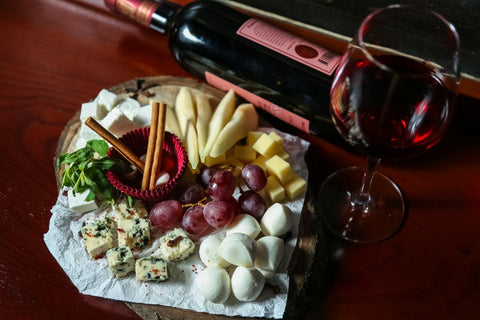Tannic and full-bodied in warm climates
What is merlot wine?
- Traditionally used as a blending grape
- The 3rd-most grown wine grape
- Earthy and savory in cool climates
- Tannic and full-bodied in warm climates
- Has unique styles all over the world
- Usually a dry wine
- Is versatile and has easy-drinking appeal
- Has an ideal temperature range
When it comes to go-to vinos for just about any occasion, it doesn’t get more popular than Merlot wine. It’s one of the most widely-enjoyed reds in the world, next to Cabernet Sauvignon.
But, what is Merlot wine? In this post, you’ll learn everything you need to know about this versatile red, including where it’s grown, how to pair it with your food, and more!
Traditionally used as a blending grape

The Merlot varietal first started as a blending grape in the late 1700s, when French winemakers in the Bordeaux region formally labeled it as one of the ingredients in their Bordeaux wine blend.
It soon became well-known for its ability to add softness and a luscious fruit flavor to a blended wine — especially when combined with another regional favorite, Cabernet Sauvignon. These two varietals complement each other so well that they quickly became the main ingredients for the beloved Bordeaux blend!
Eventually, this blending grape became dominant as a wine in its own right. Nowadays, it’s considered one of the best reds for first-time drinkers!
The 3rd-most grown wine grape
The Merlot varietal is a pretty versatile grape — it can grow in a wide variety of climes and soils, which led to its spot in many winemaking regions around the world. In fact, it’s the 3rd-most grown wine grape in the world!
France currently holds first place for producing the most Merlot grapes, followed closely by the United States and Italy. It is also widely grown in several regions in Chile, New Zealand, Spain, Argentina, Australia, Switzerland, Bulgaria, South Africa, and even China!
Earthy and savory in cool climates
Thanks to its ability to adapt tremendously well to many climates, Merlot is known as a chameleon varietal. It even takes on the character of both its location and winemaking techniques.
Because of that, there’s a clear distinction when you’re tasting Merlot grown in cooler climates (such as North Italy and France), versus those grown in warmer climates (such as Australia and Argentina).
Cooler climates produce Merlot with an earthy flavor profile that’s very structured and has a savory finish. This kind of Merlot is often mixed up with Cabernet Sauvignon when being tasted blind.
Most people describe the taste of cool-climate Merlots as:
- Generally medium-bodied.
- Ripe or slightly tart fruit, such as boysenberry, raspberry, plum, blackberry, and fig.
- Savory notes of mushroom, truffle, and forest floor.
- Deeper notes of tobacco, bitter chocolate, coffee, and allspice.
- Some purple floral notes of herb, violet, iris, bay leaf, and mint.
- Hints of licorice and anise.
Tannic and full-bodied in warm climates
Warmer climates produce Merlot which has strong fruit notes and a full-bodied and bold profile. It also has more refined, pin-cushion-like tannins. These are often aged in oak casks, which add in vanilla and smoky cedar notes.
From warmer climates, Merlot wine tends to be more fruity with refined, pin-cushion tannins. Because of the boldness of these wines, you’ll often find they age in oak which adds vanilla, chocolate, and smoky cedar notes.
Most people describe the taste of warm climate Merlots as:
- Generally more medium-plus to full-bodied.
- Voluptuous and bold flavors.
- Big and dry fruit flavors, such as plum, candied berries, cherries, blueberry, and such.
- More floral notes, such as violet.
- Some green herbal notes, lean towards leafy rather than peppery.
- Hints of baking spice, like vanilla, cinnamon, nutmeg, and clove.
- Notes of cocoa, coffee, and mocha.
Has unique styles all over the world

As we said, Merlot grapes are chameleons, so, naturally, there are some very big differences from region to region. Based on where your Merlot wine comes from, it’ll likely feature the unique growing and winemaking style of that area.
For example, Merlot wine made in Bordeaux, France is usually grown in limestone or clay. This creates either a robust profile or a more mineral and earthy taste. An example of this is our Chateau de Saint Pey Grand Cru, which features a strong red fruit profile with a silky and aromatic finish.
Another example is those made in Italy — like our Citra Merlot Terre Di Chieti — which are characterized by a more oak-forward taste, a kick of spice, and a purplish, fruity bouquet.
Moving down to the new world regions, such as Australia, Merlot wines typically end up less powerful than the bold reds grown in this region. And, they tend to feature strong, jammy flavors of berries and plum — which you can try in our Yalumba Y Series Merlot.
Usually a dry wine
Though they do feature a wide variety of fruit flavors, such as blackberry and cherry, it doesn’t mean it’s a really sweet wine! Merlot wines are usually made in a dry style. However, it is not as dry as other reds, such as Cabernet Sauvignon, and retains a semi-sweet taste.
Not sure what a “dry” wine entails? It is simply a wine that has little to no residual sugar, meaning it isn't particularly sweet. This creates more pronounced tannins and a sense of “dryness” or a mouthwatering effect with every sip you take.
Is versatile and has an easy-drinking appeal
Merlot wines are a great option for beginner wine drinkers, thanks to their versatile flavor and smooth finish. Plus, it can pair with many different types of food!
The same qualities that make this grape varietal so easy to blend with others are the same reasons that pair it well with many types of food. It’s a great vino to play around with, so don't be afraid to experiment!
Some food pairings you can try with a bottle of Merlot are:
- Red meats like lamb, veal, beef, and pork. Try any recipe that’s roasted and savory!
- Stewed dishes, especially if they feature the meats above.
- Italian cuisine, particularly dishes with tomato sauce.
- Mushrooms.
- Cheeses — a variety of them go great with this wine. Try cheddar, gruyere, brie, camembert, gouda, and gorgonzola.
- Fish, especially white-meat fish are prepared with cream-based sauces or with a kick of spice.
Has an ideal temperature range
Like all reds, Merlot has an ideal temperature range — avoid serving this wine at room temperature, as it is too warm. This makes the great flavors of the Merlot muddled.
We recommend serving it chilled. This can be done by placing your Merlot bottle in the fridge for at least 15 minutes before you serve it. If you don’t get to finish your wine in one go, then replace the cork and stick it back in the fridge (and try to finish it within 4 days so the flavors are still fresh).
Key Takeaway
Now that you know what Merlot wine is, you know why it is one of the most popular wines in the world! This chameleon of a grape can exhibit so many different styles, is easily enjoyed by anyone, and pairs beautifully with a wide variety of cuisines and recipes.
Want to try this wine for yourself? Peruse Ralph’s Wines & Spirits’ full Merlot catalog here. We carry Merlot from several different wine regions, so you can experiment and find your new favorite red!



